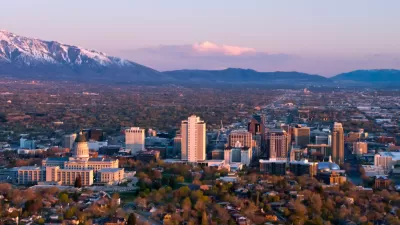An article in Governing thoroughly examines the historic and contemporary efforts of planning in Utah—especially the success of the Envision Utah planning process.
Peter Harkness provides an in-depth look at the Envision Utah method of planning for growth in a state with a rich and varied history of planning—and planning well.
First, Harkness describes Envision Utah's unique model:
"Envision Utah isn’t regional. It’s a statewide enterprise. It isn’t exactly a program, either; it’s more of a process. And it’s not a government effort, though the state and most local governments are involved. The best way to describe it is as a loosely defined, public-private-nonprofit partnership that includes most every stakeholder imaginable: local public officials, planning professionals, developers, conservationists, business and community leaders, and just about anyone else who shows an interest and a willingness to collaborate for a common purpose. Participation is entirely voluntary."
Then, Harkness succeeds the programs tangible results in growth management, some of which are listed here:
- "Despite a statewide population increase of nearly 30 percent since the 2000 Census, water consumption has fallen by more than a quarter..."
- "Emissions of inventoried air pollutants has dropped by almost half, and the state is currently working toward an even more aggressive clean air campaign."
- "Projections made in 1998, before Envision Utah got started, assumed that an additional 300 square miles of rural land would be lost to development by now. Thanks to changing land use patterns that Envision Utah has helped to promote, the actual total has been less than half that amount."
The reasons why those results have been achieved, according to the article, is a list of smart growth best practices that might seem politically impossibel in many other parts of the country.
Harkness claims, however, that Envision Utah's most impressive success has been devoted to the state's transportation system:
- "Vehicle miles traveled have actually fallen back to what they were in the late 1990s…."
- "Utah now has more transit infrastructure than many larger states, with a total of 70 stations for its rail and light rail systems."
As an example of the master planned communities that have grown out of the Envision Utah process, Harkness cites the example of Daybreak, located southeast of Salt Lake City, which received the platinum award for suburban smart growth from the National Association of Home Builders in 2011. The article also includes an illustration of the Envision Utah process and a lot more about how the Envision Utah process was launched, the planning and political context of the state, and other programs that have followed its model.
FULL STORY: Utah’s Secret Weapon for Long-Range Planning

Planetizen Federal Action Tracker
A weekly monitor of how Trump’s orders and actions are impacting planners and planning in America.

Maui's Vacation Rental Debate Turns Ugly
Verbal attacks, misinformation campaigns and fistfights plague a high-stakes debate to convert thousands of vacation rentals into long-term housing.

San Francisco Suspends Traffic Calming Amidst Record Deaths
Citing “a challenging fiscal landscape,” the city will cease the program on the heels of 42 traffic deaths, including 24 pedestrians.

Amtrak Rolls Out New Orleans to Alabama “Mardi Gras” Train
The new service will operate morning and evening departures between Mobile and New Orleans.

The Subversive Car-Free Guide to Trump's Great American Road Trip
Car-free ways to access Chicagoland’s best tourist attractions.

San Antonio and Austin are Fusing Into one Massive Megaregion
The region spanning the two central Texas cities is growing fast, posing challenges for local infrastructure and water supplies.
Urban Design for Planners 1: Software Tools
This six-course series explores essential urban design concepts using open source software and equips planners with the tools they need to participate fully in the urban design process.
Planning for Universal Design
Learn the tools for implementing Universal Design in planning regulations.
Heyer Gruel & Associates PA
JM Goldson LLC
Custer County Colorado
City of Camden Redevelopment Agency
City of Astoria
Transportation Research & Education Center (TREC) at Portland State University
Jefferson Parish Government
Camden Redevelopment Agency
City of Claremont





























